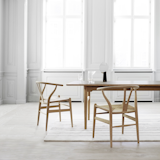Born 1968 in Zurich, Switzerland, Obrist currently lives and works in London, where he is co-director of exhibitions and programs as well as director of international projects at the Serpentine Gallery. Obrist’s prolific career has included such accomplishments as curator of the Museum in Progress, Vienna (1993-2000), curator at the Musée d’Art Moderne (2000-today), and curator and co-curator for more than 200 solo and group exhibitions and biennials internationally since 1991. Obrist’s other accomplishments also include the New York Prize Senior Fellowship for 2007-08 from the Van Alen Institute, and roles as a contributing editor for Abitare, Artforum, and Paradis Magazine.
As part of Sculpture for Strolling (2005), Pistoletto advises participants: "After reading the daily newspaper, immerse it in water then form a small sphere by compressing the wet newspaper with one's hands. Enlarge the sphere by adding new daily newspapers soaked in water. Continue this procedure until the sphere is a meter in diameter. When well dried out, roll the newspaper sphere outside in the streets and the squares as a "sculpture for strolling."
According to ICI:
“Featured in at least 50 different locations worldwide, including Australia, China, Denmark, France, Germany, Mexico, Costa Rica, Slovenia and Uruguay… The driving force behind the exhibition is aptly summarized in the words of Marcel Duchamp, who states that ‘art is a game between all people of all periods.’ He is only one of several predecessors to have shaped the modus operandi of [do it], which also draws from…art of the 1960s and 1970s as well as Fluxus practices.” Called a “middle finger to Art” by some, this project deliberately tries to hone the anything goes attitude which has fueled revelatory movements ranging from Conceptual and Minimalism to punk rock.
do it: the compendium, Independent Curators International (ICI), New York and D.A.P./Distributed Art Publishers, Inc., May 2013, 448 pages. ISBN: 978-1-938922-01-5. Foreword and acknowledgements by Kate Fowle and Frances Wu Giarratano. Introduction by Hans Ulrich Obrist. Essays by Bruce Altshuler, Hu Fang, Virginia Perez-Ratton, and Elizabeth Presa. Available to purchase at Curators International.
Hans Ulrich Obrist was invited by Kazuyo Sejima to interview all of the Biennale participants, an endeavor modeled after the 24-Hour Interview Marathon that launched the 2006 Serpentine Gallery. I sat here for awhile in this transformed audio/visual library, where Obrist framed a place where visitors can 'meet' the architects while resting their weary limbs.
Perhaps the family’s biggest priority was their connection to the outdoors. The north-facing facade is almost entirely made up of operable windows with screens for ventilation and—a favorite of Jeff, the family father—listening to the lullabye of cicadas and spring peeper frogs during the summer.
The joint living and dining area features a Wishbone chairs by Hans Wegner for Carl Hansen & Son, a Groundpiece sofa from Flexform, David Weeks' Tripod No. 303 floor lamp, and PP Møbler's Circle Chair and Fruit Table. The latter two are also by Hans Wegner.
During a Danish furniture trade show, Dr. Eigill Snorrason critiqued the industry for not paying enough attention to ergonomics. The Swivel Chair (1955) Wegner’s rejoinder of sorts, an elegant backrest of hand-carved wood that’s been compared to a gently bent propeller. The smooth lines, thin profile and wheels invite a sure-footed slide across any office. Manufactured by PP Møbler. Photo by Jens Mourits Sørensen.
Hollein’s design for this edgy contemporary art museum integrated angular structures amidst the cathedral and abbey of a quaint baroque village in West Germany, and managed to make it a striking yet seamless part of the landscape. The array of spaces, shapes, and designs was meant to present diverse means of presentation, yet stand on its own as a work of art.
The designers explain, “These steel windows played an integral part in making the interior feel larger and more open by blurring the boundaries between the interior and exterior.” A grey Halcyon Lake area rug, an oak chair from MAP, and Hans Wenger Wishbone chairs make for a simple, neutral palette. The painting over the fireplace is by Kate Hendry.
2,788 more photos








![According to ICI:
“Featured in at least 50 different locations worldwide, including Australia, China, Denmark, France, Germany, Mexico, Costa Rica, Slovenia and Uruguay… The driving force behind the exhibition is aptly summarized in the words of Marcel Duchamp, who states that ‘art is a game between all people of all periods.’ He is only one of several predecessors to have shaped the modus operandi of [do it], which also draws from…art of the 1960s and 1970s as well as Fluxus practices.” Called a “middle finger to Art” by some, this project deliberately tries to hone the anything goes attitude which has fueled revelatory movements ranging from Conceptual and Minimalism to punk rock.](https://images2.dwell.com/photos/6063391372700811264/6133557446188032000/original.jpg?auto=format&q=35&w=160)


























